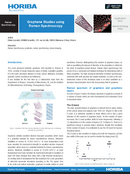

The distribution of the bi-layer (in green) and a multi-layer (in red) are easily obtained using the Classical Least Squares (CLS) fitting function of LabSpec software, to fit the spectra to user-selected “pure” spectra. Because the D band was also detected at some edges, a third spectrum representing that species was also used to fit the map (in pink).
The novel advanced material, Graphene, first report in Science in 2004, consists of single molecular layers of highly crystalline graphite. It is the basic structural element of some carbon allotropes including graphite, carbon nanotubes and fullerenes.
Distinguishing the number of graphene layers as well as quantifying the impact of disorder on its properties is critical for the study of graphene-based devices. Raman micro spectroscopy has proven to be a convenient and reliable technique for determining both of these properties.
The high structural selectivity of Raman spectroscopy, combined with both spectral and spatial resolution as well as the non-destructive nature of this technique make it an ideal candidate as a standard characterisation tool in the fast growing field of graphene.
Raman Spectroscope - Automated Imaging Microscope
Confocal Raman Microscope
MicroRaman Spectrometer - Confocal Raman Microscope
Confocal Raman & High-Resolution Spectrometer
如您有任何疑問,请在此留下詳細需求或問題,我們將竭誠您服務。
